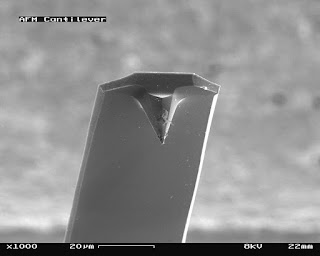 |
| View of cantilever on an atomic force microscope (magnification 1000x). Credit: SecretDisc GFDL, CC-BY-SA-3.0 |
Topics: Atomic Force Microscopy, Nanotechnology, Optics, Scanning Electron Microscope
Cell reproduction, disease detection and semiconductor optimization are just some of the areas of research that have exploited the atomic force microscope. First invented by Calvin Quate, Gerd Binnig and Christoph Gerber in the mid 1980s, atomic force microscopy (AFM) brought the atomic resolution recently achieved by the scanning tunnelling microscope to non-conducting samples, and helped to catalyse the avalanche of science and technology based on nanostructures that now permeates all aspects of modern life from smartphones to tennis rackets. On 6 July 2019 Calvin Quate died aged 95 at his home in Menlo Park, California.
Long before the development of AFM, Quate’s research had made waves in microscopy. 1978 had seen the announcement of the scanning acoustic microscope, which achieved the sensitivity of optical microscopy but probed samples so softly that it could image the interiors of living cells without damaging them. The technique uses high frequency sound waves in place of light, which penetrate deep into structures to image internal structures non-destructively. It is widely used in quality control of electronic component assembly among other applications such as printed circuit boards and medical products.
Advanced microscopy pioneer leaves broad ranging legacy
Anna Demming, Physics World
Comments